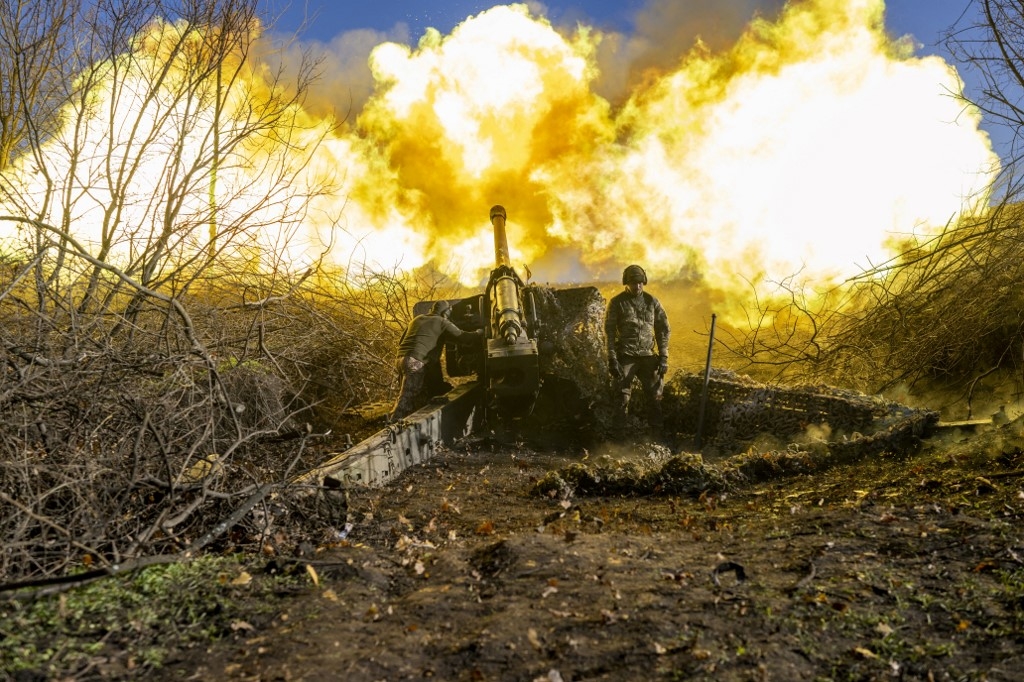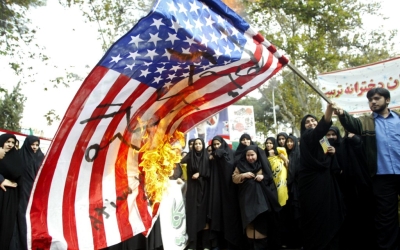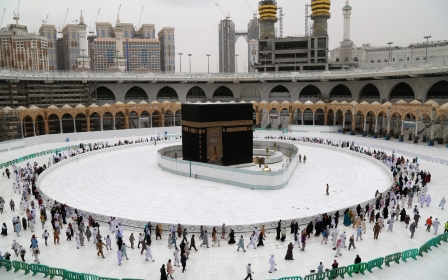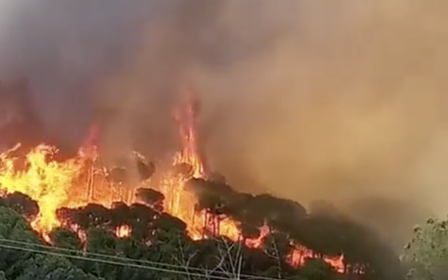The return of global catastrophe: Seven great crises and the one that’s coming

The so-called "end of history" is definitively over. A year ago I wrote in Middle East Eye that "with anarchic bilateralism and populist nationalism on the march, the current decade has all the makings of an end time for the global political order built on the ashes of 1945”.
Two and a half months later Russia invaded Ukraine, and war returned to Europe.
Historical research shows that such catastrophes are not entirely random in nature, but come along with a degree of regularity
Even before the Ukraine-Russia war, we had become familiar with the idea of the black swan - a global crisis that few experts anticipated before its arrival, that appears to come out of nowhere and spread economic and political mayhem across borders. The most recent events of this type were the global financial crisis of 2008 and the Covid-19 pandemic of 2020.
What about the great catastrophes of world history? Such cataclysmic events as the First World War, the Black Death, or the conquests of Timur or Alexander have also imprinted in the minds of generations and historians the power of certain leaders and events to upend world affairs, causing mayhem and chaos and the collapse of seemingly stable systems of power.
These events may be economic in nature, such as financial crises, or disease based, like the Black Death or smallpox pandemics, or political, like the French revolution. For progressives and those seeking a more just social order, systemic upheaval can be an opportunity for the radical re-ordering of state and societal affairs.
A history of catastrophe
Recent books have explored the way periods of catastrophe have shaped the world, such as Walter Scheidel’s The Great Leveler: Violence and the History of Inequality, from the Stone Age to the Twenty-First Century and Geoffrey Parker’s Global Crisis: War, Climate Change, and Catastrophe in the Seventeenth Century.
While Scheidel explores a huge array of secular income and wealth data sets and their relation to large-scale war, societal collapse and revolution over several millennia, Parker’s work focuses on mortality, famine, climate change and disease in the 17th century “general crisis”.
Evolutionary scientist Peter Turchin’s War and Peace and War (2005) took Arab philosopher Ibn Khaldun’s theory of asabiyya - cooperation and solidarity within social groups or tribes against decaying empires - to explore the way civilisational clashes and crises unfold over a number of generations. (Khaldun had an audience with Timur during the latter's siege of Baghdad in 1401 and discussed history with him. He said to Timur: “Sovereignty exists only because of group solidarity - asabiyya - and the greater the number in the group, the greater is the extent of sovereignty.”)
Through these works and others that attempt to delineate global, long-term trends amid the complexity and blizzard of events in world history, it is possible to identify certain patterns of change. Periods of relative stability are followed by periods of crisis and, for a critical and extended period, wars, revolutions and upheavals upend the existing world order, leaving it shattered and changed for ever.
Historical research seems to show that such changes are not entirely random in nature, but come along with a degree of regularity of which day-to-day observers may be unaware, since the trend patterns are highly elongated and form a discernible pattern over more than one average lifetime.
Seven great crises
In fact, such world-changing catastrophes or upheavals come along approximately every 120 to 150 years. They involve wars, invasions, civil war, economic crises and revolution, as well as climatic and viral events, usually in a combination of such intensity that state structures, and empires, are unable to withstand the forces involved and succumb to chaos and collapse.
In each era, these catastrophes have specific and local causes, but they forge a combined totality of interacting forces that spark grave crises of society, economy and geopolitical conflict.
The seven great catastrophes of the last millennium, in reverse chronological order, are as follows:
1910-45 - Fall of Qing dynasty in China. First World War; Russian and Mexican revolutions, collapse of Eurasian monarchies and empires. Influenza pandemic. Rise of fascism and communism.
1780-1815 - Revolutionary wars in America, France and other European states. Breakaway of Spanish American colonies; Haitian revolution. End of Holy Roman Empire. Emerging European supremacy in Asia and the Middle East.
1630-1660 - Civil war and revolution in England, Europe and China. Thirty Years War in Europe. Revolution and collapse of Ming dynasty in China. Execution of King Charles of England. La Fronde civil war in France. Japan’s era of isolation begins.
1518-1550 - Spanish conquest of Aztec and Inca empires, the Great Dying of native peoples from European epidemics. Protestant revolution in Europe. Mughal conquest of northern India.
1368-1405 - Ming dynasty established. Timur’s conquest of Byzantium, Persia, Russia and Baghdad. Decline of medieval system in Europe in wake of the Black Death; peasant revolt in England and period of civil war under Richard II.
1215-1260 - Mongol conquest of China, Persia, Kyiv, Poland and Baghdad, ending the Islamic Caliphate, creating the largest land empire the world has ever known.
1070-1100 - Seljuk Turks seizure of Byzantine Anatolia, Aleppo and Jerusalem (1071). First Crusade, invasion of Levant by western Christian forces, conquest of Jerusalem (1099).
This thesis does not discount that there were major wars, civil conflicts and other upheavals in between the peaks of crisis. Such events occur fairly frequently when analysed over long time periods; however, they do not usually bring about all-round state or imperial decline or revolution.
The difference is that outside of a major systemic crisis, the existing elites and imperial states are able to withstand a variety of threats and challenges, crush rebellions and repel invasions, fight and lose wars, and live to fight another day.
The next global crisis
There are significant variations chronologically and qualitatively to the intervals between the major catastrophes. However, it is safe to say that, if this pattern holds, sometime between now and the 2030s there is an odds-on likelihood that there will be a cataclysmic world crisis.
Many would say that since 2020, it feels as if we have entered a period of prolonged, intense crisis, although what we may be actually living through is the accumulation of conditions that are the precursors to a full-blown global upheaval.
The crises facing us are well known: a nascent global east-west conflict, involving all the major powers (USA, Russia, China and EU, as well as potentially Israel and Iran); imminent ecological breakdown leading to mass hunger and millions fleeing across borders; a global financial crisis caused by ever-rising debt and extreme inequality.
The only question is where will be the flashpoint(s) that sparks a multidimensional crisis? There are many candidates: Ukraine/Russia, China, Iran, Egypt, or yet unknown others.
Politically, traditional conservative and social democratic parties are being challenged by far-right populism and, to a lesser extent, new left and Islamist populism.
A return to stability is unlikely, and won’t happen before we enter a period of intensive, violent and prolonged crisis
This leads to the question: what could replace the decaying representative democracies, one-party states and oligarchic autocracies that currently dominate the planet? Is there a new model of governance waiting in the wings, in the groundswell of new ideas coming from various movements, such as radical green and left movements, or is a period of worldwide autocracy or neofascism more likely? Both are possible, given the gravity of the crises facing us.
Western liberals remain confident that in the battle between democracy and the authoritarian states of Russia, China and Iran, the latter will be defeated. That is a comforting narrative. Yet western elites are blind to the limits of our democratic systems, which have shown far greater capacity to protect elite wealth than to deal with the many crises facing their societies, including ever-rising inequality, broken public services, racism, climate change and poverty.
What is more predictable in the coming period is that a return to stability is unlikely, and won’t happen before we enter a period of intensive, violent and prolonged crisis on a regional and global scale.
The views expressed in this article belong to the author and do not necessarily reflect the editorial policy of Middle East Eye.
This article is available in French on Middle East Eye French edition.
Middle East Eye propose une couverture et une analyse indépendantes et incomparables du Moyen-Orient, de l’Afrique du Nord et d’autres régions du monde. Pour en savoir plus sur la reprise de ce contenu et les frais qui s’appliquent, veuillez remplir ce formulaire [en anglais]. Pour en savoir plus sur MEE, cliquez ici [en anglais].








